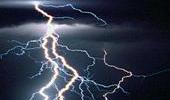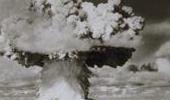|
Kinetic Energy
- Energy of motion: An external
"organized" form [KE = mv2/2].
Potential Energy
- Idea: A form of energy that
can "potentially" become motion.
- Gravitational potential energy: Depends
on how far an object is from bodies that attract it gravitationally;
Makes objects gain speed as they fall.
- Electric potential energy: Depends
on where objects are located with respect to electric charges;
Supplied by the electric company, or batteries and alternators;
Runs all our appliances, lights, ...
Internal Energy
- Idea: All forms of energy that
the molecules in matter have.
- Chemical energy: An "invisible"
potential energy inside matter; Depends on how atoms are combined,
and is released in burning, explosions; Runs our candles, cars,
...
- Mass energy: Energy matter possesses
just because of its mass, E = mc2;
In most cases it is by far larger than any other form of energy,
but only nuclear reactions can release a significant portion;
Runs the Sun.
- Thermal energy: Heat...
Thermal Energy and Heat
- Thermal energy: An "invisible" form
of kinetic energy of the random motion of atoms or molecules (500
m/s is common), including rotations and vibrations; Contrary to the
macroscopic kinetic energy, this internal one is disordered.
- Related concepts: Heat is thermal energy
transferred between two objects. What's the difference between temperature
and heat? What is the lowest possible
T? Absolute zero, 0 K = –273°C = –460°F.
- Example: It is possible to transfer
heat to an object without changing its temperature; What's going
on?
|




|


_214x220.jpg)
![]()